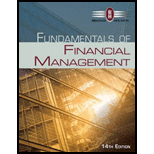
Fundamentals of Financial Management (MindTap Course List)
14th Edition
ISBN: 9781285867977
Author: Eugene F. Brigham, Joel F. Houston
Publisher: Cengage Learning
expand_more
expand_more
format_list_bulleted
Question
Chapter 6, Problem 11P
Summary Introduction
To identify:
The default risk premium.
Default Risk Premium:
A premium, which is paid by the borrower to its lender in the form of compensation of lender’s money in the regards of default risk is known as default risk premium.
Expert Solution & Answer
Want to see the full answer?
Check out a sample textbook solution
Students have asked these similar questions
Need answer.
Solve plz now
Precious metal qn solve .
Chapter 6 Solutions
Fundamentals of Financial Management (MindTap Course List)
Ch. 6 - Prob. 1QCh. 6 - Prob. 2QCh. 6 - Suppose you believe that the economy is just...Ch. 6 - Prob. 4QCh. 6 - Suppose a new process was developed that could be...Ch. 6 - Prob. 6QCh. 6 - Prob. 7QCh. 6 - Suppose interest rates on Treasury bonds rose from...Ch. 6 - Prob. 9QCh. 6 - Suppose you have noticed that the slope of the...
Ch. 6 - Prob. 1PCh. 6 - REAL RISK-FREE RATE You read in The Wall Street...Ch. 6 - EXPECTED INTEREST RATE The real risk-free rale is...Ch. 6 - DEFAULT RISK PREMIUM A Treasury bond that matures...Ch. 6 - MATURITY RISK PREMIUM The real risk-free rate is...Ch. 6 - INFLATION CROSS-PRODUCT An analyst is evaluating...Ch. 6 - EXPECTATIONS THEORY One-year Treasury securities...Ch. 6 - Prob. 8PCh. 6 - Prob. 9PCh. 6 - Prob. 10PCh. 6 - Prob. 11PCh. 6 - MATURITY RISK PREMIUM An investor in Treasury...Ch. 6 - Prob. 13PCh. 6 - EXPECTATIONS THEORY AND INFLATION Suppose 2-year...Ch. 6 - EXPECTATIONS THEORY Assume that the real risk-free...Ch. 6 - Prob. 16PCh. 6 - Prob. 17PCh. 6 - Prob. 18PCh. 6 - Prob. 19PCh. 6 - INTEREST RATE DETERMINATION AND YIELD CURVES a....Ch. 6 - Prob. 21IC
Knowledge Booster
Similar questions
arrow_back_ios
SEE MORE QUESTIONS
arrow_forward_ios
Recommended textbooks for you
 Intermediate Financial Management (MindTap Course...FinanceISBN:9781337395083Author:Eugene F. Brigham, Phillip R. DavesPublisher:Cengage Learning
Intermediate Financial Management (MindTap Course...FinanceISBN:9781337395083Author:Eugene F. Brigham, Phillip R. DavesPublisher:Cengage Learning

Intermediate Financial Management (MindTap Course...
Finance
ISBN:9781337395083
Author:Eugene F. Brigham, Phillip R. Daves
Publisher:Cengage Learning